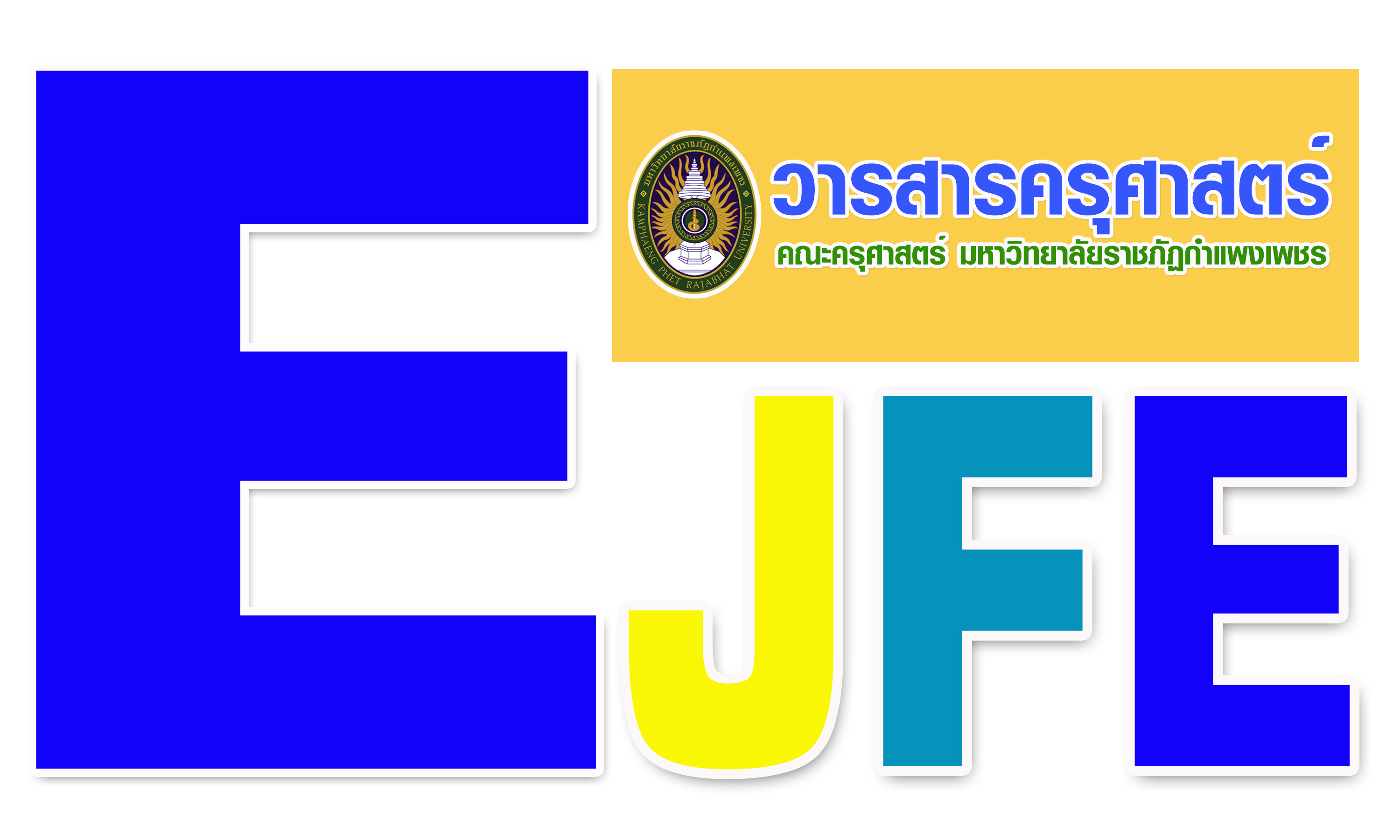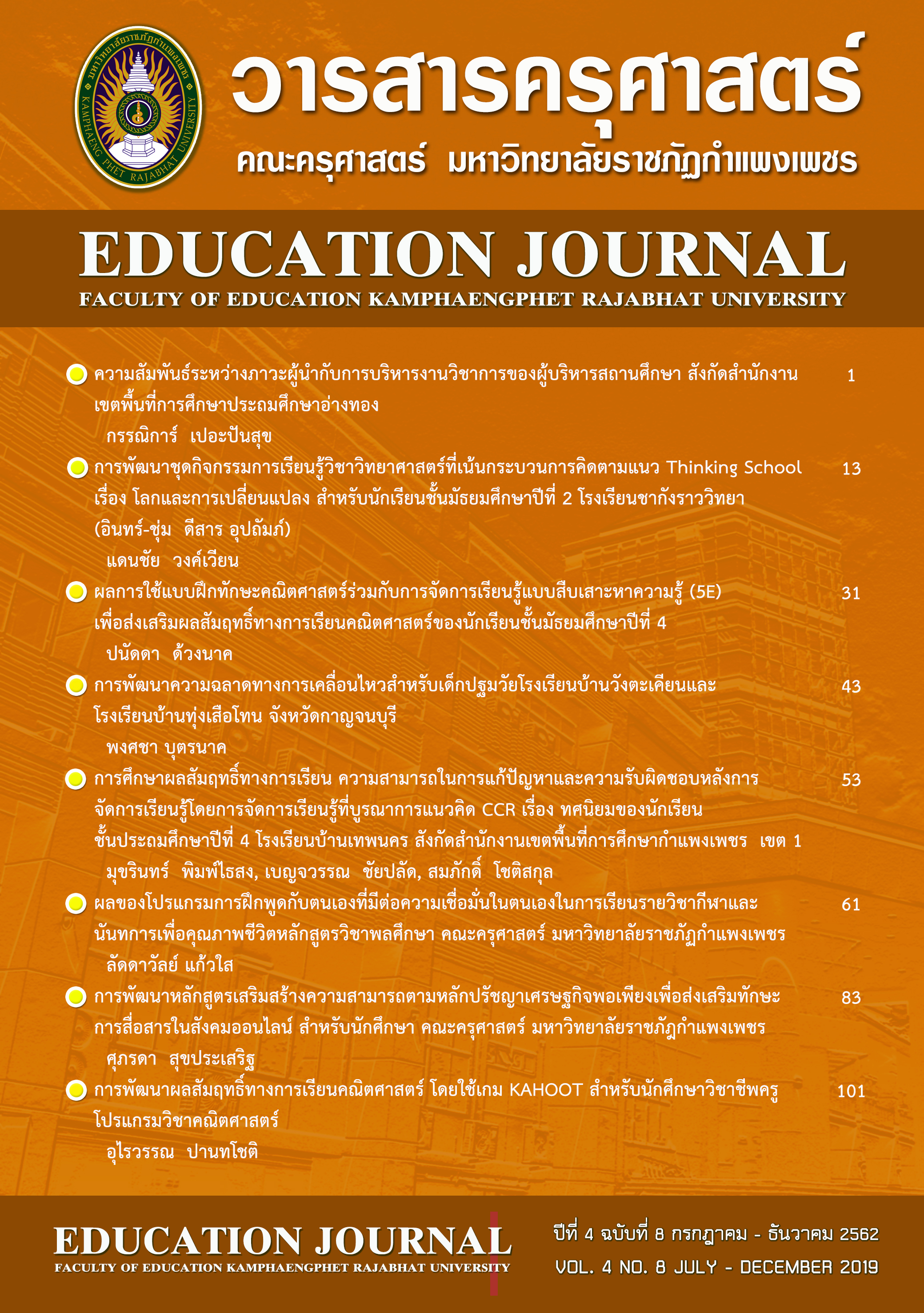การศึกษาผลสัมฤทธิ์ทางการเรียน ความสามารถในการแก้ปัญหาและความรับผิดชอบหลังการจัดการเรียนรู้โดยการจัดการเรียนรู้ที่บูรณาการแนวคิด CCR เรื่อง ทศนิยมของนักเรียนชั้นประถมศึกษาปีที่ 4 โรงเรียนบ้านเทพนคร สังกัดสำนักงานเขตพื้นที่การศึกษากำแพงเพชร เขต 1
Main Article Content
บทคัดย่อ
การวิจัยนี้มีวัตถุประสงค์เพื่อ (1). เพื่อเปรียบเทียบผลสัมฤทธิ์ทางการเรียนคณิตศาสตร์ เรื่อง ทศนิยม ของนักเรียนชั้นประถมศึกษาปีที่ 4 กับเกณฑ์ (2). เพื่อเปรียบเทียบผลสัมฤทธิ์ทางการเรียนคณิตศาสตร์ก่อนและหลังเรียน เรื่อง ทศนิยมของนักเรียนชั้นประถมศึกษาปีที่ 4 (3). เพื่อศึกษาทักษะในการแก้ปัญหาทางคณิตศาสตร์หลังเรียน เรื่อง ทศนิยม ของนักเรียนชั้นประถมศึกษาปีที่ 4 (4). เพื่อศึกษาความรับผิดชอบต่อการเรียนคณิตศาสตร์ เรื่อง ทศนิยม ของนักเรียนชั้นประถมศึกษาปีที่ 4 ตำบลเทพนคร อำเภอเมืองกำแพง จังหวัดกำแพงเพชร กลุ่มตัวอย่าง เป็นนักเรียนชั้นประถมศึกษาปีที่ 4 ในภาคเรียนที่ 2 ปีการศึกษา 2561 จำนวน 13 คน เครื่องมือที่ใช้ในการวิจัย ได้แก่ แผนการจัดการเรียนรู้ที่บูรณาการแนวคิด CCR แบบวัดทักษะการแก้ปัญหาทางการเรียนคณิตศาสตร์ แบบวัดความรับผิดชอบต่อการเรียนคณิตศาสตร์ วิเคราะห์ข้อมูลโดยใช้โปรแกรม SPSS ค่าเฉลี่ย และส่วนเบี่ยงเบนมาตรฐาน ผลวิจัยพบว่า 1. นักเรียนชั้นประถมศึกษาปีที่ 4 มีผลสัมฤทธิ์ทางการเรียนคณิตศาสตร์ เรื่อง ทศนิยม หลังได้รับการสอนโดยการจัดการเรียนรู้ที่บูรณาการแนวคิด CCR สูงกว่าที่เกณฑ์กำหนดไว้ร้อยละ 70 อย่างมีนัยสำคัญทางสถิติที่ระดับ .05 2. นักเรียนชั้นประถมศึกษาปีที่ 4 มีผลสัมฤทธิ์ทางการเรียนคณิตศาสตร์ เรื่อง ทศนิยมหลังได้รับการสอนโดยการจัดการเรียนรู้ที่บูรณาการแนวคิด CCR สูงกว่าก่อนเรียน อย่างมีนัยสำคัญทางสถิติที่ระดับ .05 3. นักเรียนชั้นประถมศึกษาปีที่ 4 มีทักษะทางการเรียนคณิตศาสตร์ โดยรวมอยู่ในระดับมาก เมื่อพิจารณารายข้อ พบว่า นักเรียนมีทักษะในการนำเสนอผลงานที่ตนทำได้อย่างหลากหลายวิธี มีค่าเฉลี่ยสูงสุด รองลงมา คือ นักเรียนมีทักษะการแก้ปัญหาเมื่อเกิดปัญหาในระหว่างการทำกิจกรรม และ นักเรียนมีทักษะการเชื่อมโยงความรู้เดิมกับความรู้ใหม่ที่ได้รับ และนักเรียนมีทักษะการคิดสร้างสรรค์ในการทำกิจกรรมต่าง ๆ และ นักเรียนมีทักษะการแก้ปัญหาในการปฏิบัติกิจกรรม ตามลำดับ 4. นักเรียนชั้นประถมศึกษาปีที่ 4 มีความรับผิดชอบ โดยรวมอยู่ในระดับมาก เมื่อพิจารณารายข้อ พบว่า เมื่อผลการเรียนไม่ดี ได้คะแนนน้อยจะพยายามอ่านหนังสือมากขึ้น มีค่าเฉลี่ยสูงสุด รองลงมา คือ เข้าเรียนตรงเวลา และ ทำการบ้านด้วยตนเอง ตามลำดับ
Article Details

This work is licensed under a Creative Commons Attribution-NonCommercial 4.0 International License.
CC Attribution-NonCommercial-NoDerivatives 4.0
References
กระทรวงศึกษาธิการ. (2542). พระราชบัญญัติการศึกษาแห่งชาติพ.ศ. 2542. และที่แก้ไขเพิ่มเติม(ฉบับที่ 2).
ประจิม เมืองแก้ว. (2558). การพัฒนารูปแบบการจัดกิจกรรมแนะแนวตามแนวคิดจิตตปัญญาศึกษาเพื่อเสริมสร้างการเห็นคุณค่าในตนเองสำหรับนักเรียนชั้นมัธยมศึกษาปีที่ 3. หลักสูตรปริญญาการศึกษาดุษฎีบัณฑิต สาขาวิชาหลักสูตรและการสอน มหาวิทยาลัยนเรศวร.
ประเวศ วะสี. (2549). จิตตปัญญาศึกษา มหาวิทยาลัยมหิดล. มติชนรายวัน 17 กรกฎาคม 2549.
ปฏิมา ธิกุลวงษ์. (2548). การเปรียบเทียบผลการเรียนรู้เรื่อง ทศนิยม ของนักเรียนชั้นมัธยมศึกษาปีที่ 1 ที่สอนด้วยวิธีสอนแบบร่วมมือกันเรียนรู้ เทคนิค TGT และวิธีสอนแบบปกติ. วิทยานิพนธ์ ปริญญาศึกษาศาสตรมหาบัณฑิต สาขาวิชาหลักสูตรและการนิเทศ ภาควิชาหลักสูตรและวิธีสอน มหาวิทยาลัยศิลปากร.
พงษ์ศักดา นามประมา. (2557). การพัฒนาทักษะการเรียนรู้ในศตวรรษที่ 21 สู่ความเป็นพลเมืองอาเซียนด้วยรูปแบบการสอนโดยใช้วิจัยเป็นฐาน (RBL) ในรายวิชาเพิ่มเติม ส 33202 อาเซียนศึกษา 2 สำหรับนักเรียนชั้นมัธยมศึกษาปีที่ 6.วิทยานิพนธ์ปริญญาศึกษาศาสตรมหาบัณฑิต มหาวิทยาลัยขอนแก่น.
สุภาพร ชูสาย. (2556). ผลของการจัดกิจกรรมการเรียนการสอนในรายวิชาพฤติกรรมมนุษย์กับการพัฒนาทักษะชีวิตด้วยกระบวนการเรียนรู้ตามแนวจิตตปัญญาศึกษา. กลุ่มวิชาจิตวิทยาการศึกษาและการแนะแนว คณะครุศาสตร์ มหาวิทยาลัยราชภัฏเพชรบูรณ์.
วศิน เกิดดี. (2557). การเปรียบเทียบผลสัมฤทธิ์ทางการเรียน และเจตคติต่อการเรียนคณิตศาสตร์ทาโกรัส กลุ่มสาระการเรียนรู้คณิตศาตร์ ของนักเรียนชั้นมัธยมศึกษาปีที่ 2 ระหว่างการจัดกการเรียนรู้แบบอุปนัยกับการจัดการเรียนรู้แบบนิรนัย. วิทยานิพนธ์ ครุศาสตรมหาบัณฑิต สาขาวิชาหลักสูตรและการสอน มหาวิทยาลัยราชภัฏเทพสตรี.
วราภรณ์ สารีพันดอน. (2555). การเปรียบเทียบผลสัมฤทธิ์ทางการเรียน กลุ่มสาระการเรียนรู้คณิตศาสตร์ เรื่อง บทประยุกต์ ชั้นประถมศึกษาปีที่ 6 ความสามารถด้านการคิดวิเคราะห์และความรับผิดชอบต่อการเรียนที่ได้รับการสอนแบบปกติกับการสอนที่มีการจัดเรียงลำดับเนื้อหาสาระแบบปรับใหม่และจัดกลุ่มใหม่. กศ.ม. สาขาวิชาการวิจัยการศึกษา มหาวิทยาลัยมหาสารคาม.
วิจารณ์ พานิช. (2556). สนุกกับการเรียนในศตวรรษที่ 21. กรุงเทพฯ : มูลนิธิสดศรี-สฤษดิ์วงศ์.
สถาบันทดสอบทางการศึกษาแห่งชาติ(องค์การมหาชน). (2559). รายงานผลการทดสอบทางการศึกษาระดับชาติขั้นพื้นฐาน (O-NET) ชั้น ประถมศึกษาปีที่ 6. เข้าถึงได้จาก http//www.niets.or.th.
สุวภาพ พวงแก้ว. (2556). การจัดการเรียนรูปแบบซิปปาร่วมกับการใช้เทคนิคของโพลยาที่มีต่อผลสัมฤทธิ์ทางการเรียนและทักษะการแก้โจทย์ปัญหาคณิตศาสตร์ของนักเรียนชั้นประถมศึกษาปีที่ 3. ปริญญาการศึกษามหาบัณฑิต สาขาหลักสูตรและการสอน มหาวิทยาลัยทักษิณ.
สำนักวิชาการและมาตรฐานการศึกษา. (2553). แนวทางการจัดการเรียนรู้ ตามหลักสูตรแกนกลาง การศึกษาขั้นพื้นฐาน พุทธศักราช 2551. กรุงเทพฯ : พิมพ์ครั้งที่ 2, โรงพิมพ์ชุมนุม สหกรณ์การเกษตรแห่งไทย จำกัด.
อาชัญญา รัตนอุบล. (2547). การสอนแบบเน้นการวิจัยโดยใช้สัญญาแห่งการเรียนรู้” ในการเรียนการสอนที่มีการวิจัยเป็นฐาน. 61-79.กรุงเทพฯ: คณะครุศาสตร์ จุฬาลงกรณ์มหาวิทยาลัย.

